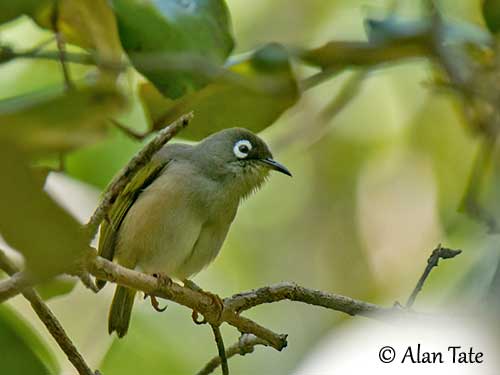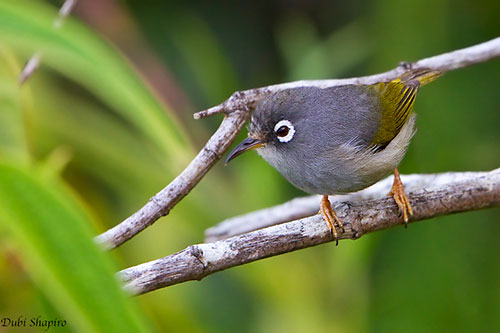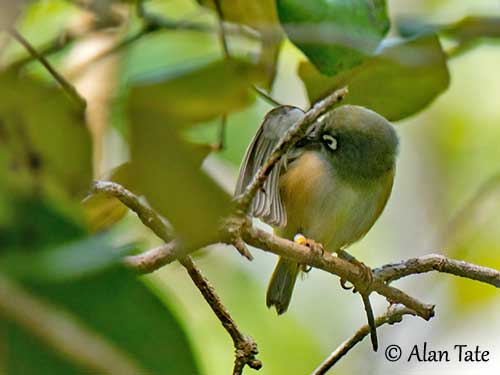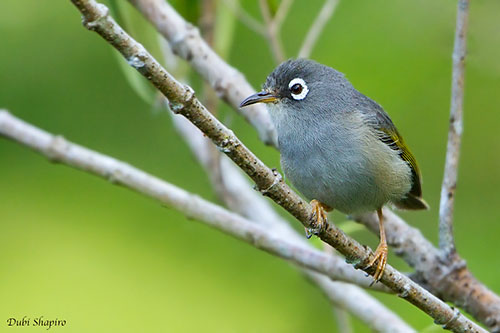
Fr: Zostérops de Maurice
Ang: Mauritius Olive White-eye
All: Mauritiusbrillenvogel
Esp: Anteojitos de Mauricio
Ita: Occhialino di Mauritius
Nd: Olijfgroene Mauritiusbrilvogel
Sd: mauritiusglasögonfågel
Photographers:
Dubi Shapiro
Dubi Shapiro Photo Galleries & Dubi Shapiro's Pictures on IBC
Alan & Ann Tate
AA Bird Photography
Text by Nicole Bouglouan
Sources:
HANDBOOK OF THE BIRDS OF THE WORLD Vol 13 by Josep del Hoyo-Andrew Elliot-Jordi Sargatal - Lynx Edicions – ISBN: 9788496553453
Birds of Madagascar and the Indian Ocean Islands Par Roger Safford, Adrian Skerrett, Frank Hawkins – ISBN: 1472924118, 9781472924117- Editeur: Bloomsbury Publishing, 2015
The Mauritian Wildlife Foundation (MWF)
Mauritian Wildlife Foundation Olive White-Eye Recovery Program - Annual Report 2008-09
ZSL - Olive white-eye recovery programme
Breeding biology of the endangered Mauritius Olive White-eye Zosterops chloronothos
Wikipedia, the free encyclopaedia
Home page
Page Passeriforme Order
Mauritius Olive White-eye
Zosterops chloronothos
Passeriformes Order – Zosteropidae Family
INTRODUCTION:
The Mauritius Olive White-eye is endemic to Mauritius and it is one of the rarest birds of this island. It has very restricted habitat and depends heavily on forest. It is confined to the wet upland forest.
It feeds on nectar and insects. It nests in a cup-shaped structure built in tree fork, and both adults share the nesting duties.
The Mauritius Olive White-eye is continuously affected by habitat destruction, involving large foraging trips to find suitable flowers, although some introduced plant species are important nectar sources.
The population is declining and the breeding success is very low, in spite of several conservation efforts. The Mauritius Olive White-eye is currently listed as Critically Endangered.
DESCRIPTION OF THE BIRD:
Biometrics:
Length: 10 cm
Weight: 7,5/9 g
The Mauritius Olive White-eye has grey head to mantle, whereas rest of upperparts is mostly olive-green.
The underparts are paler, mostly pale whitish-grey. The flanks are tinged pinkish-buff and the undertail-coverts are pale yellow.
On the grey head, the lores are blackish. Ear-coverts are paler than forehead and crown. Chin and throat are whitish.
The long, slightly decurved bill is blackish to dark brown, with yellow base of lower mandible. The eyes are dark brown, surrounded by conspicuous, broad, white eyering. Legs and feet are horn-coloured.
Male and female are similar, and the juvenile resembles adults.

RANGE:
The Mauritius Olive White-eye is found on Mauritius, in the Black River Gorges National Park, Maccabee and Bel Ombre. The species has been introduced to Isle aux Aigrettes.
HABITAT:
The Mauritius Olive White-eye frequents the wettest upland tropical forests where it can find nectar and insects. This native forest is heavily degraded by exotic plant species such as Psidium and Syzygium jambos. It is usually present above 300 metres of elevation. It has adapted to the Syzygium jambos more open thickets that provide the bird important food sources. It usually avoids gardens and stands of invasive tree species.
CALLS AND SONGS: SOUNDS BY XENO-CANTO
The Mauritius Olive White-eye typical call is an explosive “pit pit pit” usually repeated in trill or mixed notes. We can also hear a ringing “ch-rrreee” and an abrupt “tche”. The bird gives some “pit” calls while feeding in flocks at nectar sources.
The song is made of short, rapid, warbled phrases alternating with “pit” calls. It is often repeated during several minutes.

BEHAVIOUR IN THE WILD:
The Mauritius Olive White-eye is a restless nectar and insect feeder. It feeds on nectar from more than 40 plant species, both favourite endemic and introduced plants. But native Eugenia and Syzygium jambos species are commonly visited.
Insect diet includes dragonflies, beetles, grubs, cocoon contents and adult insects up to 2 centimetres long.
It forages through the canopy in foliage, bark, branches, shrubs, fallen branches and inflorescences. It rarely hovers but tends to feed actively like sunbirds (Nectariniidae) and sunbird asities (Philepittidae).
Insects can be caught by gleaning, but flying insects are snapped up in flight. The bird defends a small area around a favoured flower.
The Mauritius Olive White-eye also defends a small area around the nest-site during the breeding season. Both parents incubate, brood and feed the chicks. Distraction displays such as “broken-wing display” or other injury displays are performed near the nest if the chicks are present.
Outside of breeding season, the Mauritius Olive White-eye wanders below the usual limit of 300-400 metres of elevation, and can be seen over the C plateau and remnants of native vegetation.
It may perform long flights of up to 500 metres when searching for nectar sources. The short, rounded wings involve weak, undulating flight.

REPRODUCTION OF THIS SPECIES:
The breeding season extends from September to March, with peak in September/November.
The Mauritius Olive White-eye builds a cup-shaped nest placed 2-10 metres above the ground in tree fork. It is made of leaf veins held together with spider webs. The cup is lined with plant fibres, animal hair and mainly feathers.
The female usually lays two pale blue eggs, rarely three. Both adults share the incubation during 12-13 days. The chicks are fed by both parents and fledge two weeks after hatching. The adults perform distraction displays when the chicks are in the nest.
They are heavily affected by nest predation by introduced species such as Macaca fascicularis and Rattus rattus, and the breeding success is very low.
PROTECTION / THREATS / STATUS:
The Mauritius Olive White-eye has very restricted range in SW and C of the island where it is very rare. Degradation and loss of suitable habitat, and nest predation by introduced species have caused the decline of the population, ranging from 346 pairs in 1975 to 200 pairs in 1993 and 93-148 pairs in 2001.
A population viability analysis by Maggs in 2016 concluded that the Mauritius Olive White-eye would go extinct within 50 years.
Conservation actions are underway, but the Mauritius Olive White-eye is currently listed as Critically Endangered.
